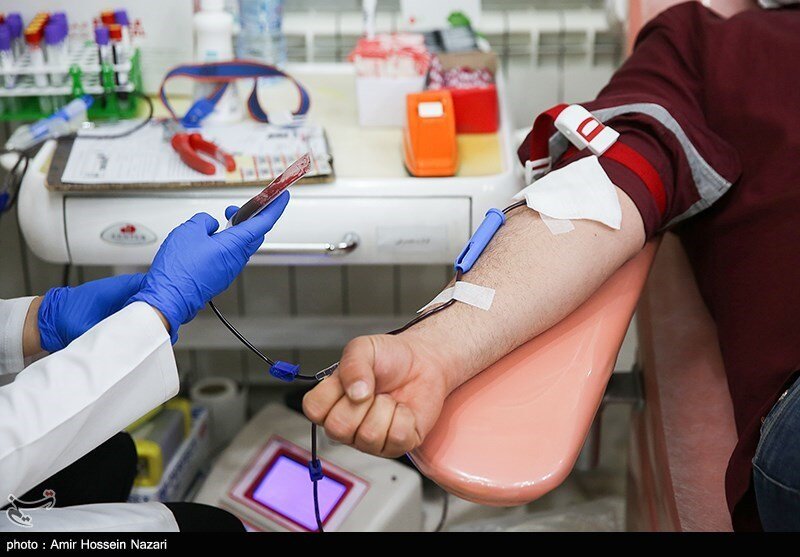Blood Transfusion Organization announces development plans

TEHRAN – Mostafa Jamali, CEO of the Blood Transfusion Organization, while explaining the development plans of the Organization, announced the opening of 6 blood donation centers on the occasion of Government Week (August 24-30).
The organization has advanced laboratories with high-quality equipment control, complying with standards of developed countries, he said.
In this organization, services such as packed blood cells, plasma, platelets, cord blood bank, and irradiated blood are performed in a specialized manner and knowledge, he added.
The development of the blood transfusion organization should move towards justice-centered. In the past, there were 11 screening centers in the country, and now four centers are being set up in other provinces, and by the end of the [Iranian calendar] year (March 20, 2023), all provinces will have a screening center, he explained.
On donated blood, hepatitis "B", "C" and "HIV" tests are conducted, and screenings in this field are especially desired.
Referring to setting up blood donation centers in the country as one of the other development programs of the Blood Transfusion Organization, he emphasized that “in many cities and also villages, we do not have blood donation centers, and with the support of the government, we intend to set up mobile centers to make blood donation accessible in rural areas.”
Antibody tests will be added to the system and advanced blood transfusion services will be developed with government support, he stated.
Currently, 204 blood transfusion centers are operating in the country, and 6 more centers will be opened during Government Week, he added.
In the past years, we could meet 20-30 percent of hospitals’ needs for blood and blood products in provinces and big cities, but now we can fully meet the whole hospitals’ needs, he also said.
Currently, the level of blood storage in the country is good and high. For example, in the province of Sistan-Baluchestan, we were in a red state recently, and the level of blood storage was in the range of two to three days, but now the storage is in the range of 12 days, he explained.
Pointing to the umbilical cord blood bank, he said that there are stem cells in the umbilical cord blood, and the blood stored in the blood transfusion bank will be provided free of charge to leukemia or thalassemia patients.
However, the amount of blood stored in the cord blood bank is low due to the high maintenance costs and the tests that need to be performed, and it needs the support of the authorities, he further noted.
Referring to the human leukocyte antigen (HLA) bank, he said that the primary use for human leukocyte antigen (HLA) testing is to match organ and tissue transplant recipients with compatible donors.
Iran on par with Europe and U.S.
According to the reports provided by the World Health Organization, Iran competes with Europe and the U.S. in blood donation indices, even outpacing them in one or two cases.
Iran is among the countries of the Eastern Mediterranean region as a reference in the field of blood donation activities.
According to the World Health Organization, Iran competes with Europe and the U.S. in blood donation indices.
While blood donation in 70 countries still depends on replacement or paid donors, Iran is the first country in the region that has enjoyed voluntary blood donation by 100 percent since 2007.
More than 85 percent of all donated blood worldwide is used to produce blood products, while the rate is 65 percent in Eastern Mediterranean countries. Iran ranks among the highest-income countries in terms of converting more than 97 percent of the blood donated by people to plasma-derived medicinal products (PDMP).
Only 55 of 171 countries produce PDMP through the fractionation of plasma collected in the reporting country. A total of 90 countries reported that all PDMP are imported, 16 countries reported that no PDMP was used during the reporting period, and 10 countries did not respond to the question, according to WHO.
Iran currently has the highest blood donation rate in the Eastern Mediterranean region, so out of 9.9 million blood donation units in this region, more than two million belongs to Iran.
Also, the index of blood donation is 25 per 1,000 populations, while in the member states of the Eastern Mediterranean region, this number is 14.9 per 1000.
Blood donation in Iran has long been done voluntarily as over 2.1 million Iranians donate blood annually, Bashir Haji-Beigi, the former Blood Transfusion Organization spokesman, said in June.
There are currently 178 blood donation centers in the country, with Fars, Khorasan Razavi, Khuzestan, Tehran, and Mazandaran provinces having the largest number of blood donation centers, he stated.
FB/MG
Leave a Comment